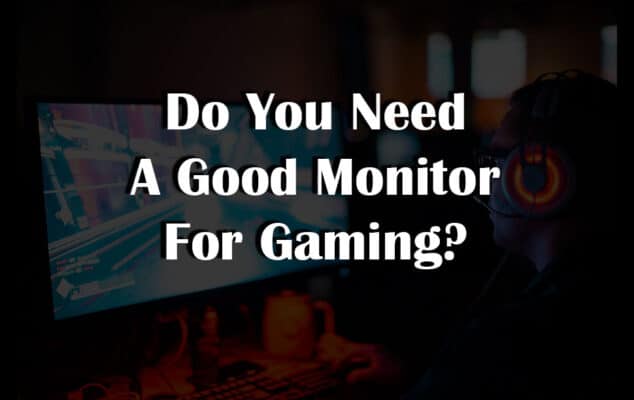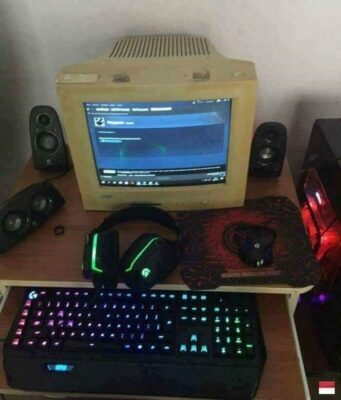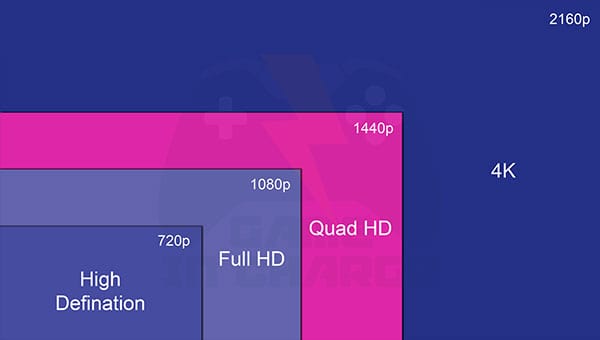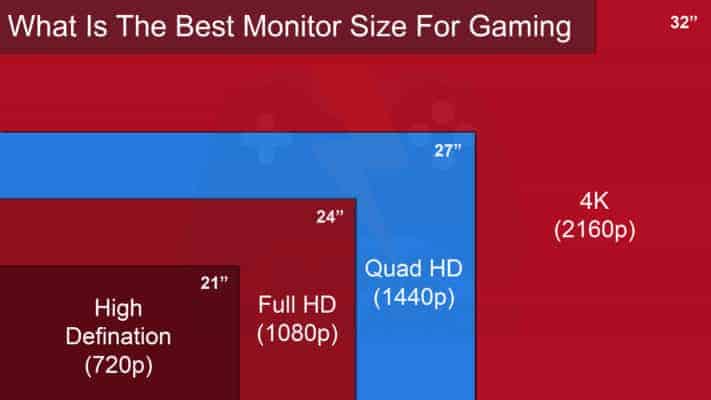You may be wondering the answer to the question of do you need a good monitor for gaming. Many people think that you do, and they would be correct. A good monitor can mean the difference between an enjoyable gaming experience and a frustrating one. In this blog post, we will take a look at some of the factors you need to consider when buying a gaming monitor.
If you want to get the most out of your games, then the answer is yes. Many people skimp on their monitors when they’re building or buying their gaming rigs, and that’s a big mistake. A good monitor can make all the difference in the world when it comes to gameplay.
So, Do you need a good monitor for gaming?
Yes, you need a good monitor for gaming if you are into competitive gaming where good monitors have high response time, high refresh rate, and high resolution with low input lag which gives an advantage in a competitive area as well as an immersive gameplay experience.
The perfect monitor for gamers is one that has a high response time, refresh rate, and resolution with low input lag. Gamers want immersion in their gameplay so they can react quickly without any delay from the screen telling them what’s happening or where objects are located on-screen.
High-end monitors are a must for those who want the best gaming experience possible. Gaming is all about having the best possible experience, and with a good monitor for your gaming PC, you will be able to do just that. A great screen will give your games an enhanced visual experience with faster-paced battles and more immersive graphics than ever before.
When making a decision on whether or not to get yourself an expensive gaming monitor, there are many factors that need consideration. Make sure you take note of your preferences and rank them accordingly so when it comes time for purchase.
1. Gaming Style
The type of gaming you prefer is a big determining factor in what kind of monitor will work for your needs. A good gaming monitor will make any player more focused and productive. The input provides information about what kind of device should be used but also goes into detail as to why these particular features are beneficial for gamers.
Casual Gaming
You don’t need a good monitor for casual gaming. All you really need are some simple guidelines on what type of display settings, screen resolutions and refresh rates should work well with your gameplay style in mind- whichever one fits these qualifications best will be just fine.
Competitive Gaming
If playing first-person shooters or roleplaying games with occasional scenery navigation, then go ahead and get yourself a good gaming monitor. To stay on top of your game, it is important that you use the proper equipment. One such piece is gaming monitors which can help provide an advantage when competing against other players in online games or tournaments.
2. Gaming Monitor vs Regular Monitor
While all monitors have some similar features, there are many differentiating factors to consider when buying gaming vs. regular monitors that will help you get what your eyes need for long hours of gameplay. The key differentiating factors are response time, refresh rate, screen resolution, input lag, panel type, display size, aspect ratio, and design.
| Factor | Gaming Monitors | Regular Monitors |
| Response Time | 0.5 – 5ms | 8 – 15ms |
| Refresh Rate | 30 – 360Hz | Usually 60Hz |
| Screen Resolution | up to 4K | Usually 1080p |
| Input Lag | Low | High |
| Panel Type | Available in TN, VA & IPS | TN & VA |
| Display Size | 21 – 32 inches | 19 – 34 inches |
| Aspect Ratio | Standard, Ultra & Superwide | Usually Standard |
| Design | Flat & Curved | Usually Flat |
If you’re looking for the best monitor to suit your needs, keep reading! The following factors should be considered when making this decision. Make sure that all preferences are noted and ranked accordingly so they can have an impact on which type of screen is right for you.
Also Read: What is the Difference between Gaming Monitor and Regular Monitor? 7 Best Factors To Consider
3. Response Time
Your monitor response time can affect your gaming experience. The faster the image is displayed on the screen and received by all components of hardware within milliseconds, which will result in less input lag for players who care about competitive gameplay.
When it comes to gaming, the difference between 1ms and 5 ms isn’t very noticeable. But if you want an accurate portrayal of what’s on-screen with your fast-paced shooting games like FPS then go for a monitor that has minimal delays so video signals can be displayed as they were meant: in crystal clear quality.
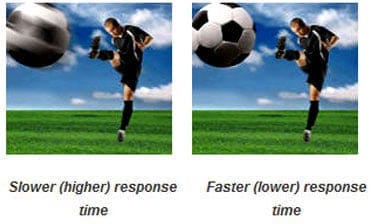
When it comes to gaming, the right monitor can make or break your experience. Make sure you’re getting one with a response time and refresh rate that matches up best for each game style but also takes into consideration how fast an image should appear on screen so do some research before making this purchase.
| Factor | Response time | Refresh rate |
| Range | 5 milliseconds or below | 75 Hz or above |
| Scale | Lower is better | Higher is better |
| Sweet spot | 1 ms | 144 Hz |
Also Read: What Is The Best Response Time For A Gaming Monitor? 7 Best Ways To Find Out
4. Refresh Rate
The FPS is what we gamers look out for, but the frames per second (FPS) matter more than just how many pictures are being shown on screen. The refresh rate affects neither your GPU output nor gameplay responsiveness so doesn’t worry about it.
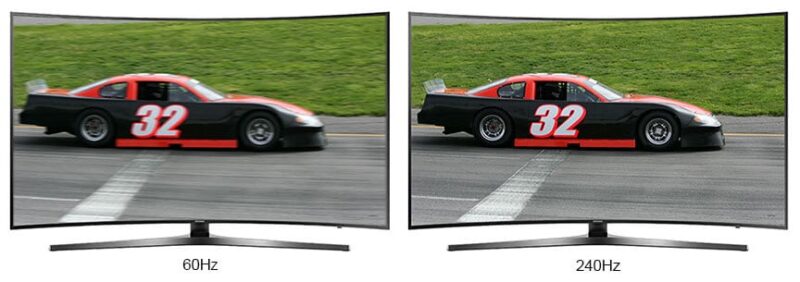
When it comes to gaming, a higher refresh rate is crucial. Most great monitors have rates greater than 100Hz and if you want the most competitive experience possible then be sure that your monitor has at least 120 Hz, though anything above will help reduce motion blur too! There are even 240Hz screens available that allow players with fast fingers or strategies totally eliminate their enemies’ advantages through precision gameplay.
The difference between a 60Hz and 144 Hz monitor is like night and day. When you’re playing video games, the faster your screen refreshes its image (the higher Hertz), it makes all those images appear smoother without any hiccups or glitches in-between them – making life easier for gamers who want an edge over their competition.
| Factor | Response time | Refresh rate |
| Range | 5 milliseconds or below | 75 Hz or above |
| Scale | Lower is better | Higher is better |
| Sweet spot | 1 ms | 144 Hz |
To get the most out of your gaming experience, make sure you check both monitor response time and refresh rate. Find what’s best for low input lag with a nice range so it will suit any situation without being too high-end or low-end on either side – just right.
Also Read: What Refresh Rate Is Good For A Gaming Monitor? 8 Best Factors To Consider
5. Screen Resolution
The screen of a monitor is measured in width and height. For instance, an industry-standard Full HD 1080p resolution means that the device has 1920 x 1080 for each dimension which makes it generous enough to view all your favorite shows or games without any issues with clarity.
The resolutions of today’s video games are varied, with gamers opting for different options depending on what they plan to play. For instance, 1440p is popular among those looking at the best performance and visuals possible but if you’re after stunning 4K/2160P graphics then your best bet would probably be one of those higher rates settings.
Also Read: What Is The Best Resolution For Gaming? 8 Significant Ways
6. Input Lag
If you play competitive games, then the input lag on your monitor matters. Competitive gamers need as little wait in between button presses and reactions while playing their favorite titles where every millisecond counts and since most monitors have low enough lags that can unnoticed during regular use.
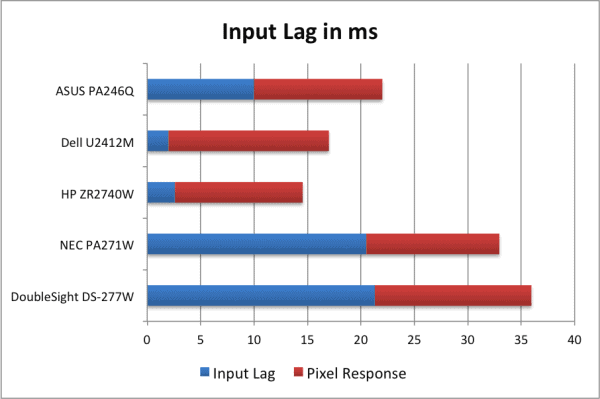
To ensure you get the best gaming experience, make sure to find a monitor with a slower response time and shorter pixel delays. Your mouse or keyboard also needs low lags for optimal performance in-game as well! Check out how different brands measure input lag.
7. Panel Type
TN, VA & IPS panels are the three most common types of display technology used in monitors. Each has its advantages and disadvantages so it’s important to consider which one fits your needs best before making a purchase decision.
| Aspects | Panel Type | ||
| TN | VA | IPS | |
| Response Time | 1ms | 1 – 4ms | 4 – 10ms |
| Viewing Angle | Limited | Better | Excellent |
| Image Quality | Poor | Good | Excellent |
TN panels are known for their fast response times, but they come at the expense of color reproduction and viewing angles. The good news is that there are VA panel screens where you can still get a decent level of visibility while sacrificing less in terms of image quality.
The perfect viewing angle for gamers is about 15 degrees when situating themselves in front of a monitor, but it’s even more immersive if you have the right desk chair. You’ll be able to get just what your eyes need without any strays or distractions.
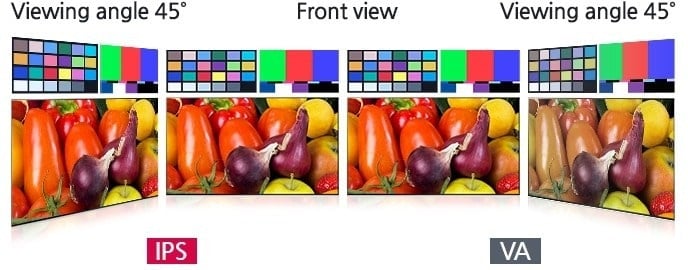
TN and VA panels are two different types of display technology that can produce great images, but they have their drawbacks. The cheaper alternatives like these won’t give you the same viewing experience as other high-end options do which is why it might be worth considering something more affordable before making your purchase decision final.
8. Display Size
Screen sizes vary, so you’ll be able to find one that fits your needs. The ranges range from less than 21 inches all the way up to well over 30″ screens and they are priced similarly according to what size is needed for optimum performance.
With the perfect combination of screen resolution and aspect ratio, a 27-inch monitor is your best bet for gaming. Not only does it have an incredible picture quality but also supports 1080p or 1440 x 900p resolutions so you can get all those pixels without any headaches.
When it comes to the monitor size, the more screen real estate you have out of your chair the better. A 24″ or 26-27 inch panel will be ideal for those who sit less than three feet from their monitors (which most gamers do).
When choosing a monitor for gaming, there are many things to consider. First and foremost is your screen resolution preference; we recommend 21-24 inches if the graphics will be intense enough on this size of device or 27″ -32″.
Also Read: What Is The Best Monitor Size For Gaming? 3 Significant Factors
9. Aspect Ratio
Widescreen monitors are the norm for gaming, but if you want to be more specific about what kind of screen size and aspect ratio will work best with your needs then there’s plenty out on the offer. The standard widescale have 16:9 aspect ratios which most gamers prefer when playing games in general.
| Aspect Ratio | Monitor Sizes |
| Standard Widescreen (16:9) | 24″ 27″ 32″ |
| Ultra-Wide (21:9) 30% wider | 29″ 34″ 38″ |
| Super Ultra-Wide (32:9) 2x wider | 43″ 49″ |
Ultra-Wides and Super Ultra widen your game with an immersive experience. For a wider mode, you need high powered PC configuration to run them properly though because they’re designed for maximum visual fidelity in mind which requires top-tier hardware at its core.
Also Read: Are Ultrawide Monitors Worth It For Gaming? 7 Best Ways To Find Out
10. Design
When shopping for a new monitor, look at the curve of your old one. Curves range from 1800R-3000+, depending on how much you want them to curved. There are a wide variety of curved monitors to choose from. The size and shape each model takes will depend on its particular characteristics, with 24″ screens being only five-inch while some larger models can stretch up 32+”.
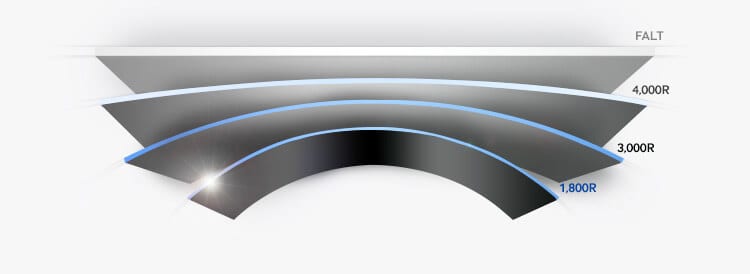
| Factors | Curved | Flat |
| Color consistency across multiple viewing angles | Better | Less effective |
| 3D depths without the headache | Better | Less effective |
| Eyestrain | Less | Normal |
| Fast-paced gaming awareness | Better | Less effective |
| Headaches for longer screen time | Less | Normal |
| Immersive gaming experience | Better | Less effective |
| Larger field of view | Better | Less effective |
| Price | High | Normal |
| Screen reflection chances | High | Normal |
| Space required on the desk | High | Normal |
| Wall mount | Less effective | Easy |
| Work involves straight lines | Less effective | Easy |
Also Read: Is A Curved Monitor Worth It For Gaming? 7 Best Ways To Find Out
TV vs Monitor for Gaming
In order for one’s set up to be at its best, there are many factors that need attention. The type of game you play will determine which features should come first on this list; however, we’ll go ahead and give some general guidelines based on most gamers’ needs
| Factors | Gaming Monitor | Gaming TV |
| Screen Size | 19-32 Inches | 32-65+ Inches |
| Resolution | 1080p / 2K / 4K | 720p / 1080p / 4K / 8K |
| Refresh Rate | 60-240Hz | Generally 60Hz |
| Response Time | 1-4ms | Above 10ms |
| Input Lag | 1-5ms | Start at 5ms |
| HDR | Only high-end monitors | Supported by most TVs |
| Viewing Distance | 2-3 Feet – Desk | 3+ Feet – Couch |
| Viewing Angles | Best for front viewing | Wide viewing angles |
| Adaptive Sync | Supported by most monitors | Only high-end TVs |
| Pricing | Medium cost for most features | High cost for most features |
The above table clearly shows that gaming monitors are more advanced and suit fast-paced games. They give you advantages over those without one, though it’s up to personal preference as to what kind of device will best suit their needs.
Also Read: TV vs Monitor For Gaming? 10 Ways To Choose The Best
What to look for in a gaming monitor?
There are many factors that you should consider when shopping for the best gaming monitor. These factors are the screen resolution, display size, refresh rate, response time, current gaming platform, panel type, widescreen or ultrawide, flat or curved, adaptive sync, HDR, and ports options.
Also Read: How To Choose A Gaming Monitor? 11 Best Factors To Consider
What to look for in a gaming monitor for PlayStation & Xbox?
The current gaming consoles, such as PlayStation 5 and Xbox Series X are powered enough to run high-end graphics games on 4K / 2160p at almost 120 frames per second. You may want to consider the following factors to look in a gaming monitor for PlayStation or Xbox.
- The viewing distance you are considering.
- The screen resolution at which you want to play games.
- The monitor display size is based on the screen resolution you chose.
- The viewing angles for the split-screen and couch buddy experience.
- The refresh rate that you want to have for gaming.
- The response time you want from the monitor.
Do you need a good monitor to play video games?
It’s true that if you want to be at the top of your game, then a good monitor is necessary. Competitive gaming can put high demands on these devices and they need responses time as well as refresh rates above all else with lower input lag which provides an advantage in competition areas along with immersive gameplay.
Also Read: Is HDR Gaming Monitor Worth It? 7 Best Factors To Consider
Can you use a normal monitor for gaming?
For casual gamers, a normal monitor is an excellent choice. The best monitor for gaming is one that can run games at higher refresh rates and great response time. Normal monitors won’t work because they’re not able to output flawless frame rates and has higher input lag if you want to play games that require higher graphical settings.
Does it matter what monitor you use for a gaming PC?
When it comes to gaming, the bare minimum these days is 60Hz. However, you should aspire for a monitor with 100 Hz or higher in order to future proof your purchase and get those quick responses needed when playing competitive games like first-person shooters with a high refresh rate and response time.
Best Gaming Monitors
These are some of the best gaming monitors on today’s market. We’ve compiled this list according to how well they can withstand stress, so if you plan on playing your games with all bells and whistles turned up then please check out these models.
We’ve added our recommendations along with pros and cons for each of the 15 gaming monitors that will give you some idea about them. You can check all on our recommended products page.
| Name | Panel Type | Screen Type | Refresh Rate | Response Time | Adaptive Sync | Our Recommendation |
| Samsung Odyssey G7 | VA | Widescreen Curved | 240Hz | 1ms | G-Sync | Read More |
| Alienware 25 | TN | Standard Widescreen | 240Hz | 1ms | G-Sync | Read More |
| ViewSonic Elite XG270 | IPS | Standard Widescreen | 240Hz | 1ms | G-Sync | Read More |
| Acer Nitro VG271U | IPS | Standard Widescreen | 240Hz | 1ms | G-Sync | Read More |
| Sceptre C305B-200UN | VA | Ultrawide Curved | 200Hz | 5ms | FreeSync | Read More |
Best Budget Gaming Monitors
These are the top 5 best gaming monitors based on our experiences. All of these have a very fast response time and an adaptive sync feature that works well with most computers, making them perfect for gamers! They also come at below $450 which means you can find something affordable too.
| Name | Panel Type | Screen Type | Refresh Rate | Response Time | Adaptive Sync | Our Recommendation |
| MSI Optix G24C | VA | Standard Widescreen | 144Hz | 1ms | FreeSync | Read More |
| Sceptre C305B-200UN | VA | Ultrawide Curved | 200Hz | 5ms | FreeSync | Read More |
| Aorus G27FC | VA | Widescreen Curved | 165Hz | 1ms | FreeSync | Read More |
| Acer Nitro VG271U | IPS | Standard Widescreen | 240Hz | 1ms | G-Sync | Read More |
| ViewSonic Elite XG270 | IPS | Standard Widescreen | 240Hz | 1ms | G-Sync | Read More |
The best gaming monitor for you is the one that fits your current needs. That may be a huge curved screen or an ultrawide display. If you want to get the most out of your gaming experience, it’s important that you have a good monitor. Whether you are playing on an Xbox or PS4, PC or Mac.
We hope this article has helped give you some idea of what to look for in a gaming monitor and given you the information necessary to make an informed decision. Let us know in the comments which monitor you ended up choosing and how well it works for your needs.
